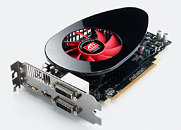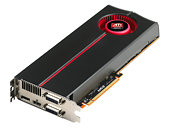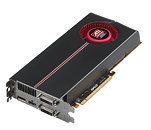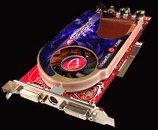
AMD Introduces ATI Radeon HD 5700 Series Graphics Processors
AMD today released its ATI Radeon HD 5700 series of mid-range graphics processors aimed to increase the company's competitiveness in the sub-$200 market, and present a mainstream graphics card series compliant with the DirectX 11 API. The series makes use of AMD's 40 nm Juniper graphics processor, that packs 1.04 billion transistors, 800 stream processors, 40 texture units, and 16 raster operation units. The 128-bit wide GDDR5 memory interface provides up to 76.8 GB/s of memory bandwidth.
The higher-end product of the two on offer, Radeon HD 5770 is priced around the $150 mark, and has all its 800 stream processors and 40 texture units enabled. It comes with clock speeds of 850/1200 MHz (core/memory), while the Radeon HD 5750 looks to cash in on the $120 point. It has 720 stream processors, 36 texture units enabled from its kitty, with clock speeds of 700/1150 MHz (core/shader). While the Radeon HD 5770 comes with 1 GB of memory, the Radeon HD 5750 comes in variants of 1 GB and 512 MB. Some of the other big selling points of these cards are low rater power consumptions of 16~18 W at idle, and 86~108 W at load. The connectivity options include two DVI-D, and one each of DisplayPort and HDMI. The cards support AMD's Eyefinity technology which allows combining three 2560x1600 pixel display-heads for a single large display head. Each of these can pair with up to three more of its kind for 4-way CrossFireX multi-GPU performance upscaling.
All major AMD board vendors, such as ASUS, Sapphire, HIS, PowerColor, Gigabyte, MSI, VisionTek, XFX, among others, have their offerings based on these GPUs ready to sell from today. Pictured below (in order) are Radeon HD 5770 and Radeon HD 5750.
The higher-end product of the two on offer, Radeon HD 5770 is priced around the $150 mark, and has all its 800 stream processors and 40 texture units enabled. It comes with clock speeds of 850/1200 MHz (core/memory), while the Radeon HD 5750 looks to cash in on the $120 point. It has 720 stream processors, 36 texture units enabled from its kitty, with clock speeds of 700/1150 MHz (core/shader). While the Radeon HD 5770 comes with 1 GB of memory, the Radeon HD 5750 comes in variants of 1 GB and 512 MB. Some of the other big selling points of these cards are low rater power consumptions of 16~18 W at idle, and 86~108 W at load. The connectivity options include two DVI-D, and one each of DisplayPort and HDMI. The cards support AMD's Eyefinity technology which allows combining three 2560x1600 pixel display-heads for a single large display head. Each of these can pair with up to three more of its kind for 4-way CrossFireX multi-GPU performance upscaling.
All major AMD board vendors, such as ASUS, Sapphire, HIS, PowerColor, Gigabyte, MSI, VisionTek, XFX, among others, have their offerings based on these GPUs ready to sell from today. Pictured below (in order) are Radeon HD 5770 and Radeon HD 5750.






